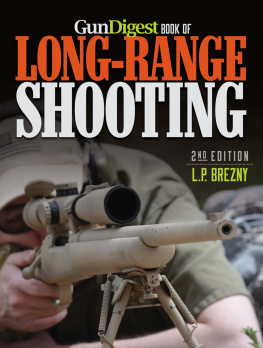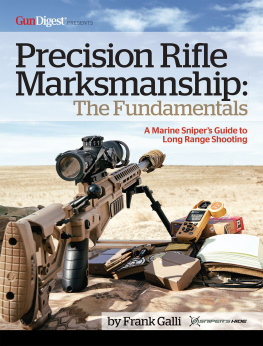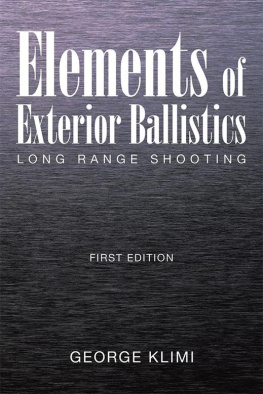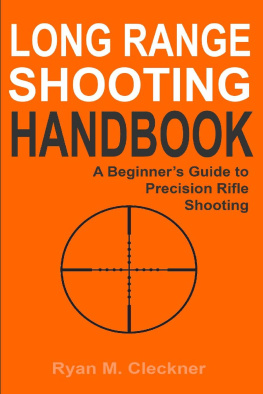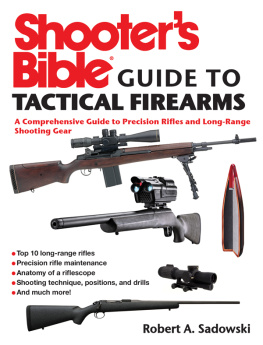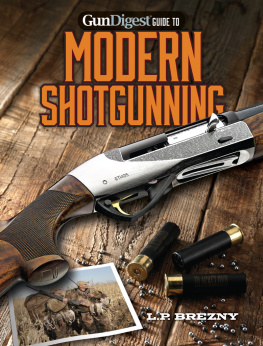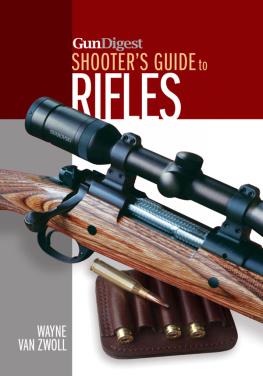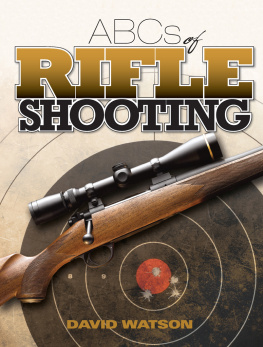L.P. BREZNY
Thank you for purchasing this Gun Digest eBook.
Sign up for our newsletter and receive special offers, access to free content, and information on the latest new releases and must-have firearms resources! Plus, receive a coupon code to use on your first purchase from GunDigestStore.com for signing up.
or visit us online to sign up at
http://gundigest.com/ebook-promo
DEDICATION
At a time when so much has been offered up by a very few courageous young men for this country, I have decided to dedicate this book to them. From the over-watch gun positions in Afghanistan and Iraq, to the rooftop surveillance and long into the night sharpshooter hides taken up by law enforcement officers across this country, we all sleep much better knowing that someone is watching out for our well-being 24/7. It has been through the extreme efforts of these warriors and lawmen that far more effective tools and skills have been developed in making that first shot a success by all of us who take up the task of shooting rifles at very long range. Thank you for your service.
INTRODUCTION
Its been seven years since the first edition publishing of Gun Digest Long-Range Shooting. In that time period, we as a nation have been on a constant war footing, one that has brought some major shifts in the way many shooters look at shooting sports, military applications, and police needs in long-range firearms. With the ultra-modern age of the advanced military sniper, special government sharpshooters such as animal control officers, commercial and public varmint hunting, open country shooters, and paper punching competition shooters, long-range shooting has been on the move toward major change. Rifles have advanced significantly, their optics are many steps further up the design ladder than even a few years ago, and ammunition wont slow down these days for anyone.

A modern TAC CZ turn-bolt in .22-250.
Where my first book centered on the idea that starting with some old-school basics can get interested shooters into the long-range game, this second edition will contain material that deals with today and what contemporary shooters needs to realize if they want to make those first-shot, one-shot hits each and every time.
Today, new firing range operations all across the country are being built that are taking into account the need for extended range services. Sports from the classic long-range High Power matches to the current phenomenon of 3-Gun events require the element of range extension in their steel target and paper punching games. The shooting public in general also seems to be enamored with the idea of a military sniper sitting on a ridgeline in some foreign place, adjusting his sights for a shot at a bad guy on the next mountainside nearly a mile away, and, so, the hobby shooter is exploring new ground, new targets, and new distances to shoot across. The snipers that inspire those greater shooting skills have changed, too. No longer are so many the get-it-done, lone-wolf specialist they used to be. Todays professional sharpshooter is more likely to be a team player working with and through speciality units designed to over watch combat situations and serving as a protective shield for their buddies fighting a ground war around them. These sports, professions, and ideas have greatly changed the face of long-range shooting in just these few years since the first book.

Kimbers 8400 Advanced Tactical. The authors is good for long-range work and is a .300 Win. Mag.
In examining all thats evolved in the last five years, this second generation of Long-Range Shooting will cover the most advanced rifles, the many specialized long-range cartridges being employed, and the other intricacies that can make a shooting system come together. Interviews with snipers, as well as discussions with the folks who build guns and ammunition and teach about and design the special gear for long-range shooting will also come to the forefront of this discussion. In fact, I believe theres so much useful information in the pages ahead, Id say that if youre not on the road to becoming a better shot after reading this book, then you just werent paying attention.


Building an at-home range on a South Dakota ranch. To the left, the authors regular shooting partner, Tom Hanson, and Toms nephew Cody (at right) set a backstop plate in place on a long-range steel target.

The author at the shooting bench with a T/C sniper rifle in .308 Win. (7.62mm NATO). The rifle is topped with a Burris Eliminator Laser Scope that works beautifully to 600 yards.
TABLE OF CONTENTS
CHAPTER 1
THE FOUNDATIONS OF
LONG-RANGE SHOOTING:
AN OVERVIEW
IT WAS 1964, WHEN the box arrived from the NRA DCM program. That was a program that allowed members of the NRA to buy up military surplus rifles for as little as a $10 bill. My brand-new, soaked-in-grease Springfield that had been manufactured in the Remington Arms plant, in 1944, had arrived. The rifle was the Springfield 30-06/03 series two-groover. That meant it had been manufactured using a less costly and less time-consuming two-groove rifling system, something that had actually been found to produce good accuracywell, at least in terms of hunting the enemy during WWII. These Springfields had been turned into effective sniper rifles for the task of reaching long-range pillbox targets in the island wars of the Pacific, or taking on a German bell tower artillery spotter in a small French town on the other side of the world.
Stripping the military stock, turning back the bolt handle, and removing the iron sights was a start toward this rifles life as a reworked centerfire long-range rifle. With the help of the Herters company, a stock blank with enough wood to allow me to carve a wide, beavertail fore-end was purchased out of the original Waseka, Minnesota, stores budget box. A pound of fiberglass bedding compound, sling studs, and a recoil pad finished off the project.

The author on the bench with a newer Kimber rifle in .300 Win. Mag. It is just one of many rifles making the grade today with the long-range crowd.
Without really knowing it at the time, that heavyweight .30-06 shooter was my gateway introduction to the art of long-range shooting. After a months work at the basement workbench, I had the makings of a first-class heavy target rifle. Almost done, I took an old, steel-tubed Weaver 10X fixed-power scope and mounted it in Weaver bases and rings. Next, I took a set of .30-06 dies for my Lyman turret press, added some Sierra 150-grain bullets (proceeded, in their lineage, by the current MatchKings), to top off some military surplus 4350 powder at 61 grains in GI cases, and I was off to learn the fine art of sending bullets toward long-range crows, woodchucks, badgers, and other critters in the random varmint department.

